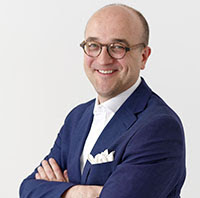|
 |
Study for the Family Portrait of Thomas More,
Drawing by Hans Holbein (1497-1543),
Pen and brush in black on top of chalk sketch on paper,
Drawn in 1527
© Kupferstichkabinett, Öffentliche Kunstsammlung, Basel |
Jesus said to his disciples: ‘Take care that no one deceives you; because many will come using my name and saying, “I am the Christ,” and they will deceive many. You will hear of wars and rumours of wars; do not be alarmed, for this is something that must happen, but the end will not be yet. For nation will fight against nation, and kingdom against kingdom. There will be famines and earthquakes here and there. All this is only the beginning of the birth-pangs.
‘Then they will hand you over to be tortured and put to death; and you will be hated by all the nations on account of my name. And then many will fall away; men will betray one another and hate one another. Many false prophets will arise; they will deceive many, and with the increase of lawlessness, love in most men will grow cold; but the man who stands firm to the end will be saved.’ |
|
|
| Reflection on the Old Master Drawing
Today we celebrate the feast of Saint Thomas More (1477-1535). He was a close friend of King Henry VIII. As a judge, he was renowned for his incorruptibility and high ethical standards, which meant he was appointed Lord Chancellor, the highest legal position at the time in England. When Henry VIII wanted to be granted a divorce from Catherine of Aragon, Thomas More opposed him. He resigned the chancellorship and retired from public life. However, as he was a prominent figure, he was asked to take an oath to support the Act of Succession, which effectively repudiated the papal religious authority. He refused, was imprisoned in the Tower of London, was found guilty of high treason for denying the King’s supreme headship of the Church, sentenced to death and executed on 6 July 1535.
In 1929, G.K. Chesterton said that Thomas More “is important today, but he is not as important now as he will be in 100 years from today.” He probably pointed towards the martyrdom of Thomas More for religious freedom and being a model of integrity and devotion. Our drawing today shows Thomas More and his family. The painting of this exact composition is lost, but this drawing survived. Drawn in 1527, this composition is seen as the earliest portrait conversation piece in English painting/drawing. Portaits before would have depicted one person, head and shoulders, on a single canvas. hence, thjis 'conversation piece' which is a more informal group portrait depicting full length figures in a domestic setting, would have been very revolutionary at the time.
Thomas More is depicted in the centre, with the engaged couple Anne Cresacre and his only son, John More, on either side of him. On the right of our painting are More's youngest daughter, Cecily Heron, and his eldest daughter, Margaret Roper. More's second wife, Alice, is kneeling on the extreme right.
‘I die the king's faithful servant, but God's first.’
- Saint Thomas More
by Patrick van der Vorst |  | |
|
|
|
No comments:
Post a Comment